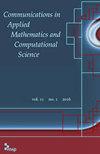Computing the quasipotential for highly dissipative and chaotic SDEs an application to stochastic Lorenz’63
IF 2.1
3区 数学
Q1 MATHEMATICS, APPLIED
Communications in Applied Mathematics and Computational Science
Pub Date : 2018-09-26
DOI:10.2140/camcos.2019.14.207
引用次数: 5
Abstract
The study of noise-driven transitions occurring rarely on the time-scale of systems modeled by SDEs is of crucial importance for understanding such phenomena as genetic switches in living organisms and magnetization switches of the Earth. For a gradient SDE, the predictions for transition times and paths between its metastable states are done using the potential function. For a nongradient SDE, one needs to decompose its forcing into a gradient of the so-called quasipotential and a rotational component, which cannot be done analytically in general. We propose a methodology for computing the quasipotential for highly dissipative and chaotic systems built on the example of Lorenz'63 with an added stochastic term. It is based on the ordered line integral method, a Dijkstra-like quasipotential solver, and combines 3D computations in whole regions, a dimensional reduction technique, and 2D computations on radial meshes on manifolds or their unions. Our collection of source codes is available on M. Cameron's web page and on GitHub.计算高耗散和混沌SDEs的准势及其在随机Lorenz ' 63中的应用
研究由SDEs模拟的系统在时间尺度上很少发生的噪声驱动转变,对于理解生物体内的遗传开关和地球的磁化开关等现象至关重要。对于梯度SDE,利用势函数预测其亚稳态之间的跃迁时间和路径。对于一个非梯度的SDE,我们需要把它的强迫分解成所谓的准势梯度和旋转分量,这在一般情况下是不能解析完成的。我们提出了一种计算高耗散和混沌系统的准势的方法,以Lorenz'63的例子为基础,增加了随机项。它基于有序线积分法、类dijkstra准势求解器,结合了全区域的三维计算、降维技术和流形或流形并集上径向网格的二维计算。我们收集的源代码可以在M. Cameron的网页和GitHub上找到。
本文章由计算机程序翻译,如有差异,请以英文原文为准。
求助全文
约1分钟内获得全文
求助全文
来源期刊

Communications in Applied Mathematics and Computational Science
MATHEMATICS, APPLIED-PHYSICS, MATHEMATICAL
CiteScore
3.50
自引率
0.00%
发文量
3
审稿时长
>12 weeks
期刊介绍:
CAMCoS accepts innovative papers in all areas where mathematics and applications interact. In particular, the journal welcomes papers where an idea is followed from beginning to end — from an abstract beginning to a piece of software, or from a computational observation to a mathematical theory.
 求助内容:
求助内容: 应助结果提醒方式:
应助结果提醒方式:


